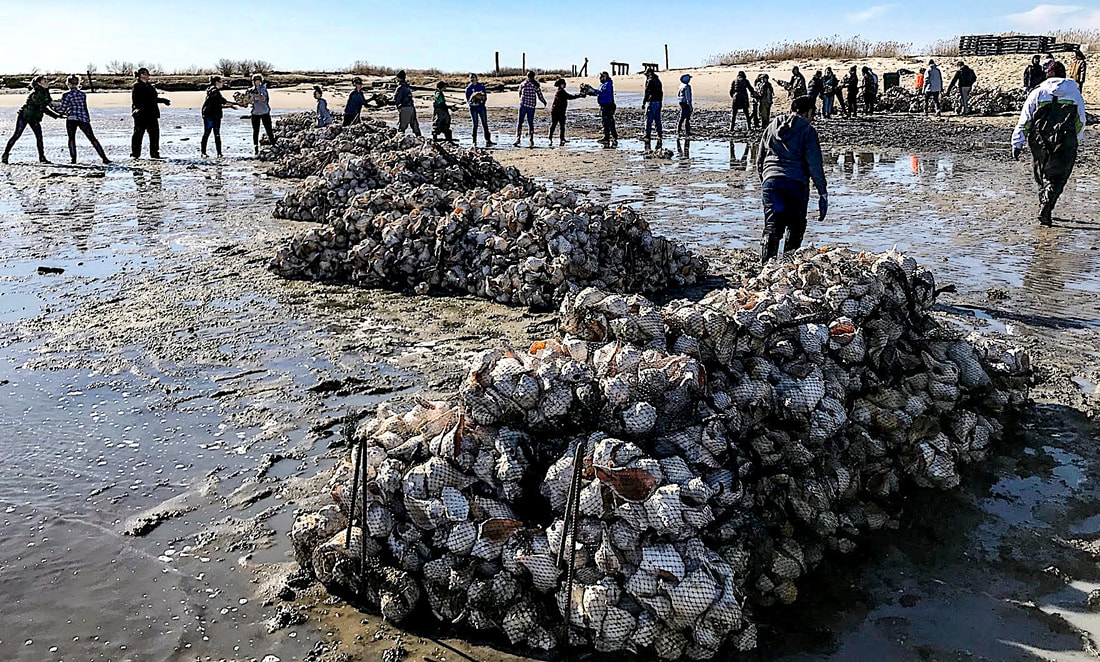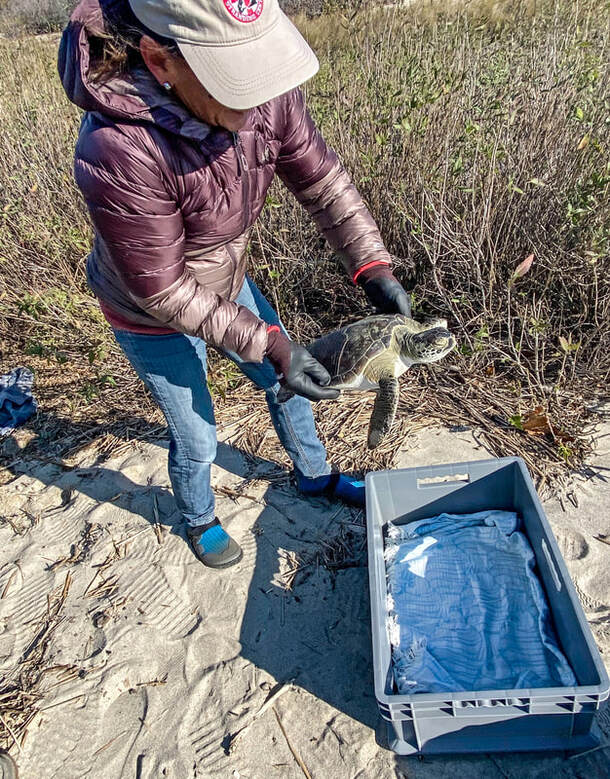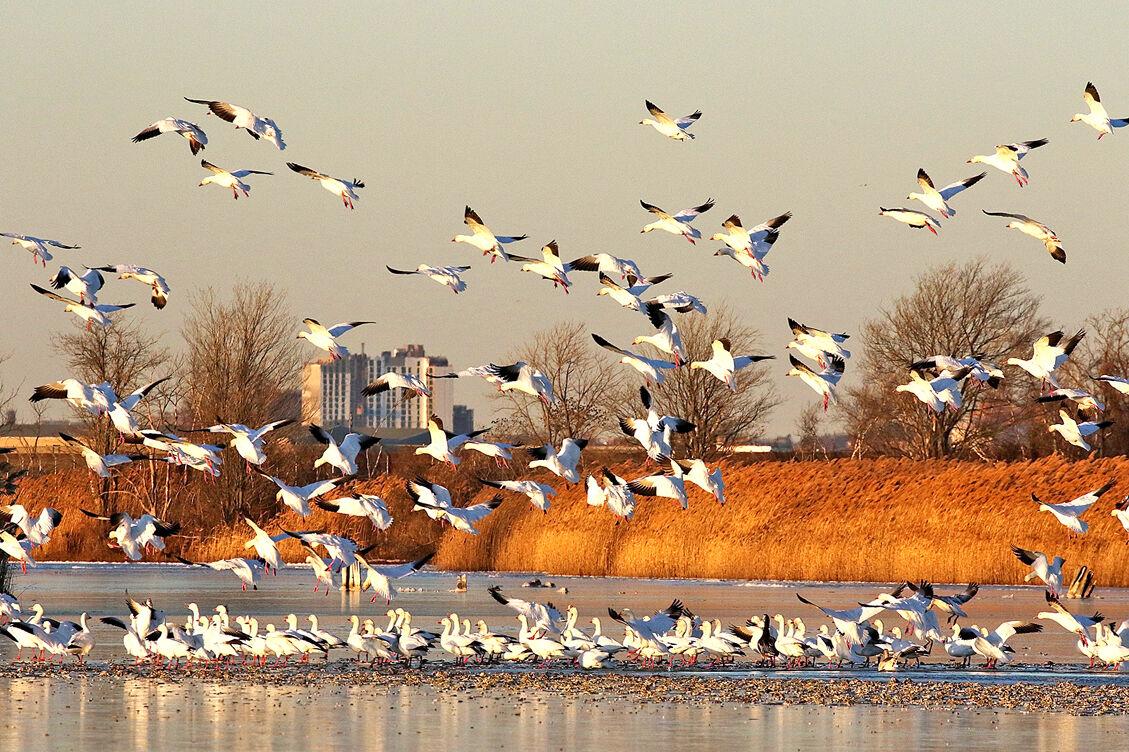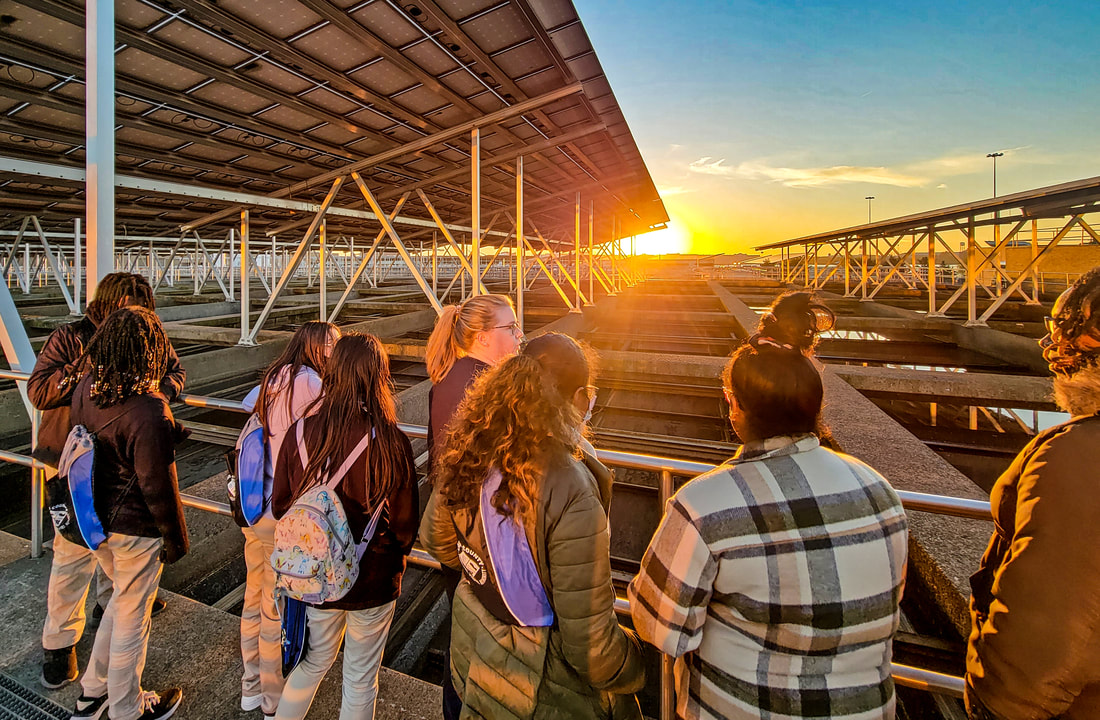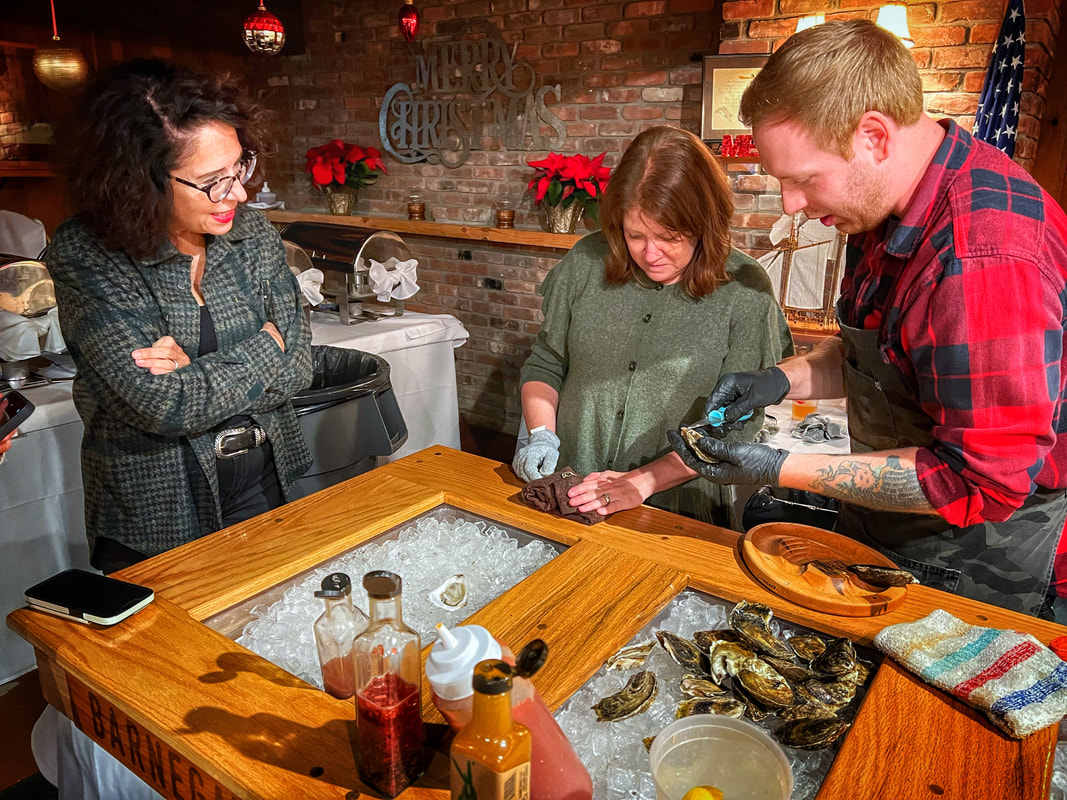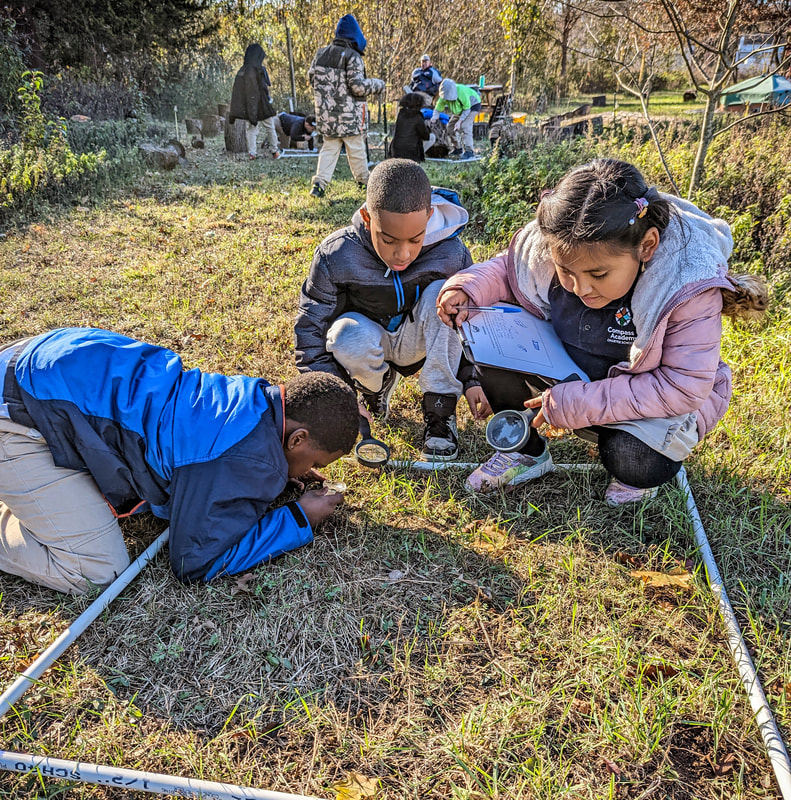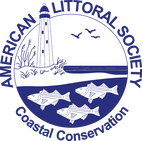|
Just before Christmas, the American Littoral Society was recognized as one of the winners of New Jersey's 23rd Annual Governor’s Environmental Excellence Awards. The Society was honored for work on Healthy Ecosystems and Habitats, specifically for constructing oyster reefs to help improve the resiliency of beaches and shorelines.
As noted in the award announcement from NJ Department of Environmental Protection (NJDEP) Commissioner Shawn M. LaTourette, the oyster reefs provide multiple benefits to the ecology such as new habitat, improved water quality, and an area that promotes re-establishment of submerged aquatic vegetation. In addition to reef construction, the work includes post-restoration monitoring and a community science program, seeding reefs with live oysters, and the use of recycled shell from local restaurants for constructing the reefs. The Littoral Society has been building oyster reefs along Delaware Bay and Barnegat Bay beaches since shortly after Hurricane Sandy in 2012. The Society also runs the "Shuck It, Don't Chuck It!" shell-recycling program, which collects shells from restaurants in Monmouth County for eventual use as part of reef and living shoreline projects. Learn more about this restoration work through our website. The Society was recognized along with 10 other organizations and individuals that demonstrated commitment and leadership on a variety of environmental issues, including environmental justice, climate change, sustainability, education, and protection of natural resources. Historically, Barnegat Bay had over 12,000 acres of eastern oyster beds. Today, nearly the entire natural oyster population is gone. With their elimination, Barnegat Bay not only lost the oysters themselves, but the ecosystem services they provided such as water filtration, wave energy mitigation, and habitat for other marine life.
Forked River Beach, in Lacey Township, NJ, is one place where the disappearance of oysters - and the reefs they build - has hit home, as high tides now bring bay water into some nearby homes. The site has lost over a hundred and fifty feet of shoreline since 1995 and erosion there has been accelerating since Superstorm Sandy in 2012. Increased sediment in water from shoreline erosion has also impacted the water quality of Barnegat Bay. A coalition led by the American Littoral Society began work in 2021 to restore Forked River Beach by constructing reefs using large wire baskets called HESCOs. Those baskets will eventually become home to full grown oysters that will help to stabilize the shoreline and clean surrounding waters. It’s an effort the local community has rallied around. Project partners and funders include: New Jersey Department of Environmental Protection, New Jersey Corporate Wetlands Restoration Partnership, Lacey Township, Bayside Beach Club, Stockton University, Albert Marine, US Fish & Wildlife Service, ReClam the Bay, Parsons Seafood, and Wildlife Restoration Partnerships. As the season gets colder and the temperatures shift in our local ocean waters, marine animal strandings become more common on our beaches. In the past, Littoral Staff have encountered stranded sea turtles on Sandy Hook and even a stranded whale near Rockaway Beach in New York.
Many animals are sensitive to abrupt changes in ocean water temperatures that can occur at this time of year. Human activities such as construction, boating and fishing can also play a role. If you see stranded, injured, sick or deceased marine mammals or sea turtles on the beach, please do not attempt to help the animals. Warming cold stunned creatures can send them into shock. If the animal may still be alive, call the stranding hotline for New York at 631-369-9829. If you find a stunned or injured marine mammal in New Jersey, contact the Marine Mammal Stranding Center at 609-266-0538 or via their website: https://mmsc.org/. For turtles, contact Sea Turtle Recover at 609-667-4076. The stranding hotline numbers are active 24 hours/7 days per week. On Sunday, November 20, the American Littoral Society - in partnership with NYC Audubon, Jamaica Bay – Rockaway Parks Conservancy, and the National Park Service - held a winter waterfowl walk at the Jamaica Bay Refuge.
The event began with a slide show focused on bird identification. That was followed by a hike around the East and West Ponds, led by the Littoral Society's Jamaica Bay Guardian Don Riepe. The focus of the excursion was looking for and learning about ducks, geese, and many other species of winter birds and other wildlife that can be found in Jamaica Bay. Fortunately, the stars of the show flew in right before the outing. “The Snow Geese just arrived from their summer breeding grounds in Hudson Bay, Canada,” Don told those in attendance. “They will spend winter in the bay.” Other birds sighted included Brant Geese, Ruddy Ducks, American Coot, Gadwall, Mallard Ducks, Mute Swans, Hooded Merganser, and Bufflehead Ducks. Information on upcoming Littoral Society walks, activities and programs can be found on our wesbite. As 2022 comes to a close, the students of Sisters Academy of New Jersey in Asbury Park and Camden Forward School in Pennsauken enjoyed their final SeaQuest lessons and field trips.
SeaQuest is the Littoral Society’s after-school, marine science enrichment program for middle school kids in under-served coastal communities. The program immerses students in a broad range of marine and environmental science concepts and career choices. This Fall, the girls at Sisters Academy learned all about fish anatomy and morphology, followed by an outdoor lesson on surf fishing, during which the girls practiced casting and used live bait. They also had classroom instruction on topics such as marine debris, oil spills, and the Littoral Society’s Operation Oyster program – which aims to re-oyster New Jersey’s bays and estuaries. The American Littoral Society’s “Shuck It, Don’t Chuck It” (SIDCI) shell recycling program has seen both change and progress over the past few months. In addition to bringing on a new director, the program also added several new restaurants, collected tons of shell, and hosted a number of fun and informative public events.
In mid-September, Kyle Patterson became the new SIDCI Program coordinator. As a Jersey local, he is excited to be contributing to the conservation of his local waters. Over the past few months, he welcomed several new contributors to the shell recycling program and has since more than doubled the number of restaurants working with us on the shell recycling program! Thanks to those efforts, the SIDCI program has collected more than 64,000 pounds of shell which might have otherwise ended up in landfills. After curing, that shell will be returned to New Jersey's bays, where it will serve as a foundation for growing new oysters. Third grade students from Compass Academy Charter School in Vineland, NJ became habitat investigators in their own Outdoor Classroom during a recent Stream Savers Education Program with the American Littoral Society. With magnifying glasses and data sheets in hand, students peeked under logs and dug into the soil to discover worms, insects, fungus and more! They learned how to use a scientific transect to square off an area for observation and practiced using their senses to notice something new. Next, students identified the elements of a successful habitat in their school yard, including food, water, shelter, and a place for animals to raise young. Students concluded their program by enhancing their school yard habitat. After making seed balls containing native wildflower seeds, they tossed the seed balls into their future pollinator meadow. When the seeds sprout in the Spring, this meadow will help absorb stormwater, provide habitat for local wildlife, and be a living laboratory for students to explore. Interested in an Education Program in the Delaware Bayshore region? Check out our Streams Savers Education Programs or Contact Michelle Rebilas, Delaware Bayshore Education and Outreach Coordinator at [email protected]. What do you think of when you think of the Littoral Society? Maybe you think about tagging horseshoe crabs on the Delaware Bay, building a living shoreline in the Barnegat Bay, or advocating for public beach access with our team at Sandy Hook. Our mission is to care for the coast and those are some of the most visible ways we do that. So, it’s no wonder that people are often surprised when they find out we also work on stormwater management in upstream cities like Bridgeton and Camden. While it might seem minor, stormwater — that’s water that can’t be absorbed into the ground when it rains due to changes that humans have made to the landscape — has a major impact on the coast. Take it from the fourth-generation oyster farmer, Barney Hollinger, who talks in the video below about how sediment carried by stormwater smothers and chokes his reefs. Clarification: Sometimes we get so excited about protecting our streams and rivers from polluted runoff that we get ahead of ourselves. Lucia around the 4-minute mark mentions that bacteria eats up oxygen levels in waterways. This is because when the algae die, they are decomposed by bacteria—this process consumes the oxygen dissolved in the water and needed by fish and other aquatic life to "breathe".
|
Archives
July 2024
Categories
All
|

